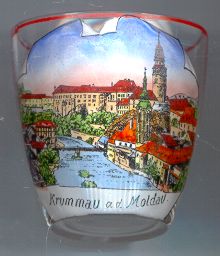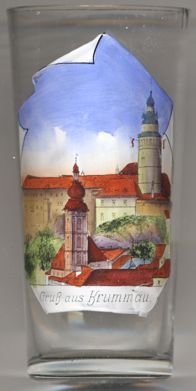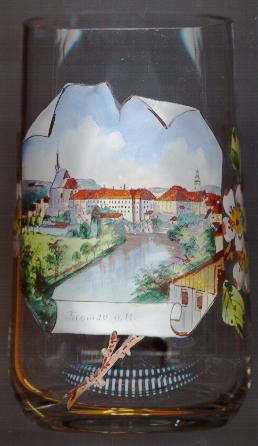

|
| ČESKÁ REPUBLIKA | CZECH REPUBLIC |
| Jihočeský kraj | South Bohemia (České Budějovice) region |
| Okres: Český Krumlov |
 Český Krumlov (in German: Krumau) is situated at an altutude of 530 m on the river Vltava (Moldau) in southern Bohemia. The towns location
in a tightly crooked meander of the river was the origin of the town's name: krumme Au means 'crooked meadow'. The name Chrumbonowe
was first mentioned in a document dating from 1253. Since the 12th century it had been in possession of the Vítkovci (Witigonen) family and was
one of their residences besides Nové Hrady (Gratzen), Rožmberk (Rosenberg) and Třeboň (Wittingau).
When the Lords of Krumlov became extinct in 1302, the estates were given to another branch of the family, the Rožmberks (Rosenbergs),
who chose it as their main residence, which initiated a flourishing period for the town. The last of the Rožmberk family sold the town
to Emperor Rudolf II in 1601, who gave it to his treasurer, Johann Ulrich of Eggenberg, in 1622. The Eggenbergs, ruled Krumlov for three generations,
were succeeded by the Schwarzenberg family in 1719. Although Krumlov lost its position as a residence town in the 19th century, it could retain much
of its original Gothic and Renaissance appearance. During the late 19th century, the old fortifications were demolished and new factories were set up.
After World War I the German population declared an independent Böhmerwald (Šumava) province, which should have become part of the new
Republic of Austria. However, Czech forces occupied the region, and the official name of the town, Krumau, was changed to Krumlov (which had been
used by the Czech part of the population since at least 1439). During World War II, Krumlov suffered only little damage, but the German-speaking
population was expelled after the war. Since the 1960s the old town was meticulously restored and finally was listed by the UNESCO as a World Cultural
Heritage in 1992 (see also list of other UNESCO heritage sites).
Český Krumlov (in German: Krumau) is situated at an altutude of 530 m on the river Vltava (Moldau) in southern Bohemia. The towns location
in a tightly crooked meander of the river was the origin of the town's name: krumme Au means 'crooked meadow'. The name Chrumbonowe
was first mentioned in a document dating from 1253. Since the 12th century it had been in possession of the Vítkovci (Witigonen) family and was
one of their residences besides Nové Hrady (Gratzen), Rožmberk (Rosenberg) and Třeboň (Wittingau).
When the Lords of Krumlov became extinct in 1302, the estates were given to another branch of the family, the Rožmberks (Rosenbergs),
who chose it as their main residence, which initiated a flourishing period for the town. The last of the Rožmberk family sold the town
to Emperor Rudolf II in 1601, who gave it to his treasurer, Johann Ulrich of Eggenberg, in 1622. The Eggenbergs, ruled Krumlov for three generations,
were succeeded by the Schwarzenberg family in 1719. Although Krumlov lost its position as a residence town in the 19th century, it could retain much
of its original Gothic and Renaissance appearance. During the late 19th century, the old fortifications were demolished and new factories were set up.
After World War I the German population declared an independent Böhmerwald (Šumava) province, which should have become part of the new
Republic of Austria. However, Czech forces occupied the region, and the official name of the town, Krumau, was changed to Krumlov (which had been
used by the Czech part of the population since at least 1439). During World War II, Krumlov suffered only little damage, but the German-speaking
population was expelled after the war. Since the 1960s the old town was meticulously restored and finally was listed by the UNESCO as a World Cultural
Heritage in 1992 (see also list of other UNESCO heritage sites).


The  castle [above left, no. 1188, near left, no. 4286, and near right, no. 4509: center left]
is located high on a steep rock above the Vltava. The castle was already mentioned in 1253. The oldest parts of the castle date from the early 13th century.
King Václav IV was imprisoned here during the Lords' revolt in 1396. The castle was later extended and was remodelled into a Renaissance residence
during the late 16th century. The next extensive building period followed in the late 18th century. Until 1782, the castle was the main residence of
the Schwarzenberg family. Since 1947/48, the castle is owned by the Czech state.
castle [above left, no. 1188, near left, no. 4286, and near right, no. 4509: center left]
is located high on a steep rock above the Vltava. The castle was already mentioned in 1253. The oldest parts of the castle date from the early 13th century.
King Václav IV was imprisoned here during the Lords' revolt in 1396. The castle was later extended and was remodelled into a Renaissance residence
during the late 16th century. The next extensive building period followed in the late 18th century. Until 1782, the castle was the main residence of
the Schwarzenberg family. Since 1947/48, the castle is owned by the Czech state.
The  castle tower [above left, no. 1188, near left, no. 4286, and near right, no. 4509: right]
(54.5 m high) is the landmark of Krumlov. Its lower parts date from the first half of the 13th and from the 14th century, the upper parts including
the arcaded gallery were completed in 1581. Two of the bells of the tower date from 1406, the other two were made in 1671 and 1744.
castle tower [above left, no. 1188, near left, no. 4286, and near right, no. 4509: right]
(54.5 m high) is the landmark of Krumlov. Its lower parts date from the first half of the 13th and from the 14th century, the upper parts including
the arcaded gallery were completed in 1581. Two of the bells of the tower date from 1406, the other two were made in 1671 and 1744.
The  former church of St. Jošt and St. Anne [above left, no. 1188: foreground right, near left,
no. 4286, and near right, no. 4509: foreground centre] was originally established prior to 1334 as part of the Rožmberk hospital.
Only a few parts of this Gothic church have remained. In 1596, the church was rebuilt in Renaissance style. Reconsecrated to the Holy Trinity it was given to
the Protestants in 1598. The church was also used by the Bohemian Brethren (Unitas Fratrum). In 1600, the church became strictly Catholic again. From 1602 until
their dissolution in 1773 the Jesuits were in charge of the church. In 1615 or 1621 the church was dedicated to St. Jošt and St. Anne as a
'German church'. The church was finally closed in 1787. In 1790, the church was auctioned off and only the tower remained in possession of the town. The former
church later served as burgher home, brewery, casino, bar and dancing hall, and shops.
former church of St. Jošt and St. Anne [above left, no. 1188: foreground right, near left,
no. 4286, and near right, no. 4509: foreground centre] was originally established prior to 1334 as part of the Rožmberk hospital.
Only a few parts of this Gothic church have remained. In 1596, the church was rebuilt in Renaissance style. Reconsecrated to the Holy Trinity it was given to
the Protestants in 1598. The church was also used by the Bohemian Brethren (Unitas Fratrum). In 1600, the church became strictly Catholic again. From 1602 until
their dissolution in 1773 the Jesuits were in charge of the church. In 1615 or 1621 the church was dedicated to St. Jošt and St. Anne as a
'German church'. The church was finally closed in 1787. In 1790, the church was auctioned off and only the tower remained in possession of the town. The former
church later served as burgher home, brewery, casino, bar and dancing hall, and shops.

The  church of St. Vitus [near left, no. 615: background left] was built in the early 17th century
in Gothic style in place of an older church. The three-naved hall church was consecrated in 1439, before the construction was completed. Later additions date
from the late 15th century and the early 18th century. The original, Baroque, top part of the church tower was replaced by a Neogothic spire in
1893–1894.
church of St. Vitus [near left, no. 615: background left] was built in the early 17th century
in Gothic style in place of an older church. The three-naved hall church was consecrated in 1439, before the construction was completed. Later additions date
from the late 15th century and the early 18th century. The original, Baroque, top part of the church tower was replaced by a Neogothic spire in
1893–1894.
Other glasses of this collection show views of
Moravský Krumlov, South Moravia.
![[scale]](lineal.jpg)